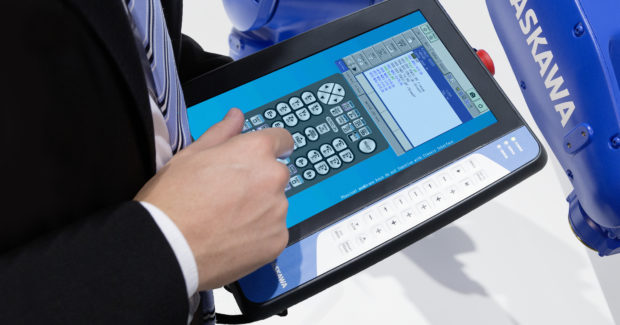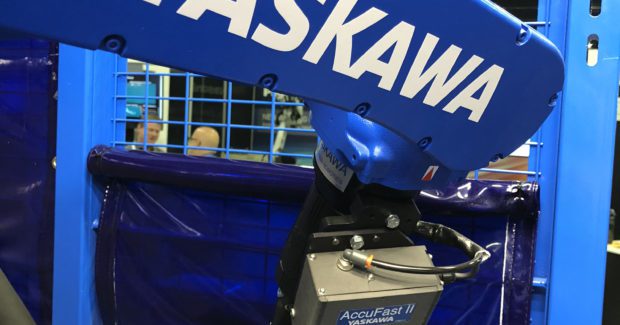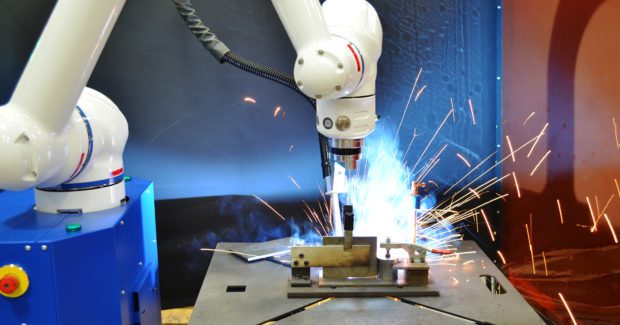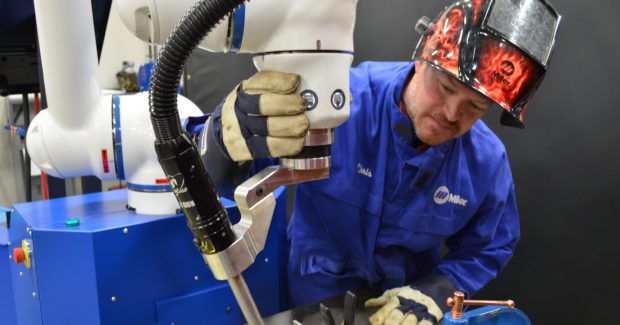The Cobot Difference: The Benefits for Small Shop Adoption
Cobots are helping job shops thrive. Thanks to advances in technologies, cobots help where welding workspace is tight and/or capacity needs a boost.
Posted: February 22, 2022
The development of easy-to-use robot technology continues to spark greater confidence among business leaders for the implementation of robotic automation and the evolution of safety standards. Highly flexible and capable of optimizing production, more affordable collaborative robots with industrial pedigrees are quickly becoming the “go to” option for welding related tasks in small- to medium-sized operations.
Once relegated to a basic collaborative arm with lower feature semi-automatic weld equipment, today’s cobots offer quite the dichotomy. Thanks to the progress of advanced technologies over the past few years, full functioning collaborative robots with feature-rich torches and intuitive pendant applications are now assisting in welding workspaces where space is tight and/or capacity needs a boost.
Whether supplementing manual welding or being rolled-up to large, heavy workpieces, extremely versatile cobots are adding capability and reliability to welding processes, bringing highly relevant applications to fruition for high-mix, low-volume production environments. As a result, a growing number of fab shop owners are looking to collaborative robots to gain greater efficiencies in several areas:
Workplace Safety
Whether completing a job that a human employee is physically unable to perform, or to accomplish a high-turnover task that would otherwise remain undone, robust cobots are efficiently performing dull, dirty, dangerous and difficult applications. For many of these shops, space is scarce. Collaborative robots with pinchless designs, smooth surfaces and built-in safety-rated Power and Force Limiting (PFL) enables safe robotic automation in proximity to humans. The use of PFL stops robot motion, as needed, to protect workers from potentially harmful contact situations, and it also reduces and eliminates the requirements for external barriers, light curtains and more.
Another feature solidifying cobots to be reliable and safe for welding applications is their IP67 rating. Designed to work in rough environments to guard against weld spatter or chemicals, IP67-rated cobots feature easy-to-clean surfaces and require no extra protection or “jacket.” Keep in mind, however, human welders should still consider all risk mitigation for the welding application being performed.
Production Efficiency
A variety of cobots now have the potential to run at industrial speeds — much faster than traditional collaborative robots. With the use of a light curtain or area scanner that can monitor human presence within a designated work area, collaborative robots can operate as fast as weld quality permits. This holds great appeal to smaller shops needing to maximize floorspace for accelerated throughput.
Workforce Resiliency
As mentioned, collaborative robots can help bolster current employee talent. Smaller operations that cannot afford to send employees off for extensive robotic training are turning to easy-to-program cobots to shorten the robot learning curve, facilitate quick implementation of a robot system and lesson re-programming downtime.
Most cobots today feature lead-to-teach capabilities for greater ease of use. I/O jogging may also be available. Made possible from a momentary command device wired to the controller, the latter “joystick”-like method is an extremely quick way to change things such as torch angle and tooling coordinates.
Common user interfaces like the Universal Weldcom Interface (UWI), can also empower less experienced cobot users, enabling full utilization of the advanced capabilities on any brand of digital welding power supply for arc welding tasks. This is highly attractive to smaller operations looking to gain easy control of any weld process or parameter such as voltage, amperage and wire feed speed. Weld modes based on process type, wire size, wire type and gas type can also be filtered.
Employing the various methods available, a worker can be trained to program a weld job in a matter of minutes, especially if prior knowledge on welding parameters and torch angles already exits. Furthermore, if the part is simple, the potential to have a cobot up and running in under an hour is very realistic.
Software in some robots, as well as select teach pendants, can also make programming more intuitive for basic handling applications that may take place in welding environments. The innovative Smart Pendant, for example, eliminates the need for conventional, and sometimes confusing, Cartesian coordinates (X, Y, Z), replacing them with smart left, right, up and down commands for novice robot users. This is done through built-in Smart Frame technology, which makes the robot operator the frame of reference for easy command of the robot movement. Combined with other features like descriptive commands and touch-to-edit job editing, tools like this simplify programming efforts to empower a more productive workforce.
Product Quality
Proven weld technologies for greater precision — that human welders often lack — is also encouraging decision makers to implement collaborative robots. Optimizing production uptime and enhancing part quality, manufacturers often use:
- Thru-arc Seam Tracking
Crucial to some parts where a weld joint could slightly vary from part to part, a thru-arc seam tracker that utilizes a current sensor in the welding power supply can be beneficial. Intuitive options, like ComArc LV (low voltage), are compatible with any brand of welder and help to compensate for workpieces or fixture inaccuracies. Using a simple method like this can go a long way to measuring arc characteristics of a weave pattern, determining variations between a cobot’s taught path and desired path. “T” and “V” groove butt joints in mild steel with up to 500 amperes of welding current can typically be tracked.
- Laser-based Seam Finding
Seam tracking can also be combined with a high-speed, laser-based seam finder for arc welding cobots. Providing more reliable and repeatable feedback to the robot controller for part positions, options, such as an AccuFast™ non-contact point laser, offer impressive sensor capabilities for increased performance. Readings on a variety of materials and angles of measurement are achievable. This method requires a torch-mounted sensor, is fairly easy to teach, and it can detect lap joints down to 1/16” thick. It is not suggested for square butt joints or highly reflective surfaces.
- Through-wire Touch Sensing
Ideal for finding the orientation of parts with simple joints and geometries, this popular option is appealing to fab shops or situations where part tolerances or tooling allow for some variance from part to part. Sometimes referred to as “wire touching,” touch sense packages use low voltage circuit during a low-speed search to detect the weld joint. No hardware is mounted on the robot, however, a wire cutter and wire brake for steady and accurate sensing is needed. This method is not suggested for lap welds with less than 3/16” material thickness, or with square butt joints.
Productivity Gains
In today’s market climate, the worker shortage is being felt on all fronts. To put it simply, fab shops cannot afford to halt production. Implementing highly portable cobots for practical welding, inspection, cutting, assembly, palletizing and machine tending applications is a step in the right direction for building competitive edge and cultivating operational gains.
For a collaborative solution featuring a cobot and a welder, pricing starts below $100,000, making it more affordable than most industrial robotic workcells. To put collaborative robot usage in perspective, one cobot can do the work of approximately 3.5 human workers. Furthermore, to justify a cobot purchase, company leaders may consider that it costs an average of $25/hour for the first four years to operate, then $8/hour after that. Depending on skill, a human welder could cost between $13 to $30/hour (plus overtime and benefits). Regarding the latter, it makes more sense to use a talented welder for design or custom welding. Similarly, moving talented workers to higher value-added tasks can foster unique benefits, like increased employee morale, for a more productive work environment and attractive return on investment.
Another consideration that manufacturers may want to weigh in their decision-making process is the marketability of having robotic automation. Potential clients may see robot availability as an asset, as it shows the ability to meet capacity. Operations that successfully use robotic automation are more likely to gain confidence from local OEMs to perform overflow work for low- to medium-volume runs.
According to Section 179 of the U.S. internal revenue code, tax deductions may also be taken for purchase of depreciable business equipment, reducing the tax burden the same year as the capital expenditure — instead of capitalizing and depreciating the asset over a period of time. Applicable to collaborative robots, the Section 179 deduction can be taken if the cobot is purchased or financed, and the full amount of the purchase price is eligible for the deduction.
The barrier to robotic automaton is considerably less than it used to be, leveling the playing field for companies of all sizes. Just as very large companies with low-mix, high-volume runs adopted robots 40 years ago and succeeded, so too will smaller operations with high-mix, low-batch orders today. High-performance yet more affordable, robots with intuitive features for greater ease of use will continue to empower small shop adoption, moving markets forward.








